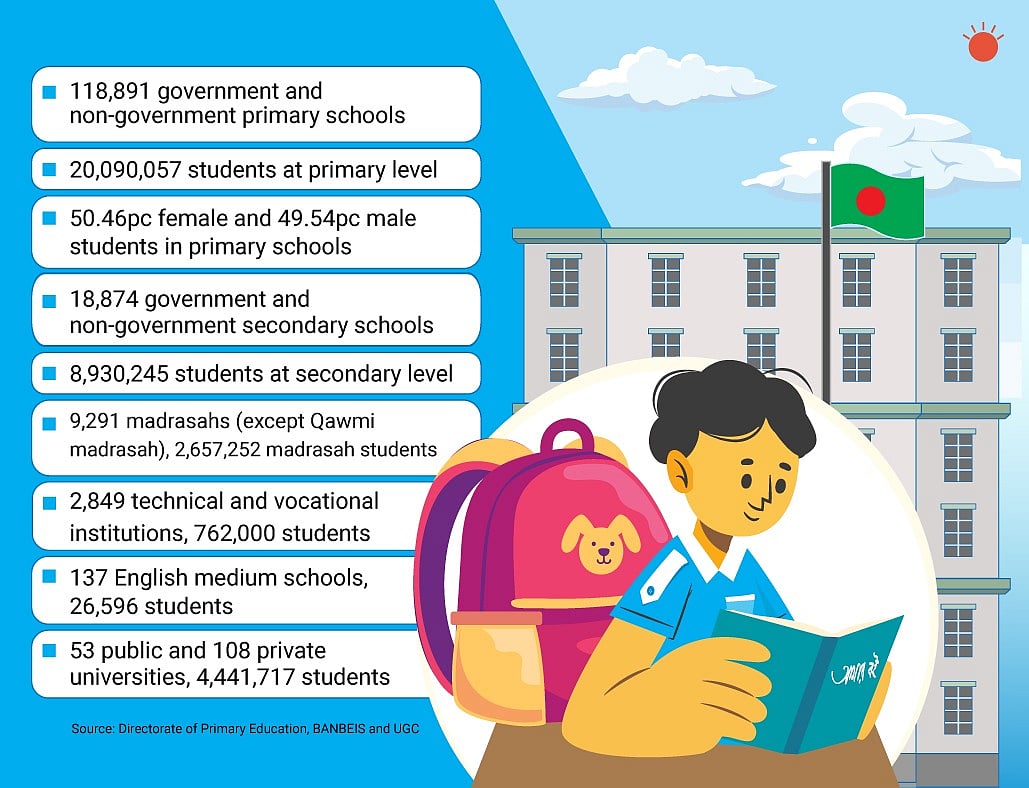Some 97 per cent of the children, who are of primary school age, are getting enrolled in schools.
The primary dropout rate has also come down to some 14 per cent and the situation has also improved at the secondary and higher levels.
However, there is also an opposite graph along with this improvement.
Still a large portion of the students is lagging behind in English and Mathematics, according to the official figures.
Some 61 per cent of the students in the sixth grade are poor in English while some 43 per cent of the students in the same class are poor in Mathematics.
The students at the primary levels are also failing to attain desired level in subjects like Bengali and Mathematics.
According to official data, English is mandatory from the primary to higher secondary level. However, many of the students, who have completed the higher secondary or further upper levels, can’t even communicate in English.
Education experts are saying, despite the expansion of education in the country, the overall education system is lagging far behind in terms of quality. As a result, the students are lagging behind in skills even after completing different levels of education. On the one hand there is a shortage of adequate teachers for quality education while on the other hand there is a shortage of skilled and qualified teachers.
The ratio of teachers and students in each class at the primary and the secondary level is quite high. Therefore, necessary steps should be taken immediately to ensure quality education.
In this case, there should be specific planning and adequate investment. At the same time, it should be monitored whether the investment is proper or not.
People affiliated with the education administration are also talking about quality education. They hope that the work of quality education can be taken one step further through the new curriculum. However, it is being observed in the time of implementing the new curriculum that there is a lack in preparation.
Although the teachers at the secondary level got five-day training after the start of the new academic calendar, the training for the teachers at the primary level is yet to start. The training activities were supposed to start virtually from Monday.
In addition to that, although the month of January is about to be finished, the students haven’t got all the books yet. The new curriculum has been introduced in the first, sixth and seventh grades this year. It will be introduced to other grades in phases from next year.
The total number of students from the primary to higher level of studies at the moment is more than 45 million. Of them, more than 20.09 million are students of more than 118,000 government and non-government primary schools.
There are more than 8.9 million students in around 19,000 government and non-government secondary schools. However, the number of secondary students is more than 10 million considering the secondary level students in the ‘school and colleges’.
Besides, the number of students in some 161 public and private universities, including the national, open and Arabic university, is around 4.45 million. A large number of students are studying in madrasah and vocational institutions. Apart from the madrasas under the government supervision, there are more than 19,000 Qawmi madrassas under self-supervision.
M Taqiue Ahsan, member of the national curriculum development and review core committee (CDRCC) and professor at the Institute of Education Research of Dhaka University, told Prothom Alo, “Now stress should be given on quality education. And to improve the quality of the education, we need to improve the learning environment first. Secondly, we have to enhance the dignity of teachers.”
Tarique Ahsan further said, “As per the new curriculum, the students will not learn at the classrooms only, they will learn from the surroundings as well. Therefore an overall preparation should be taken up."
Dignifying the teachers means increasing their salary and benefits as well as giving them importance socially and nationally, he noted.
"If we can accomplish that, then many meritorious persons will join this profession which will help us improve the quality of education. For this we have increased the investment in education. Besides, the allocation for education should be increased to 6 per cent of the GDP," Ahsan added.
